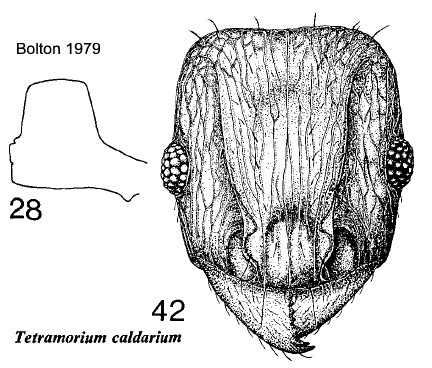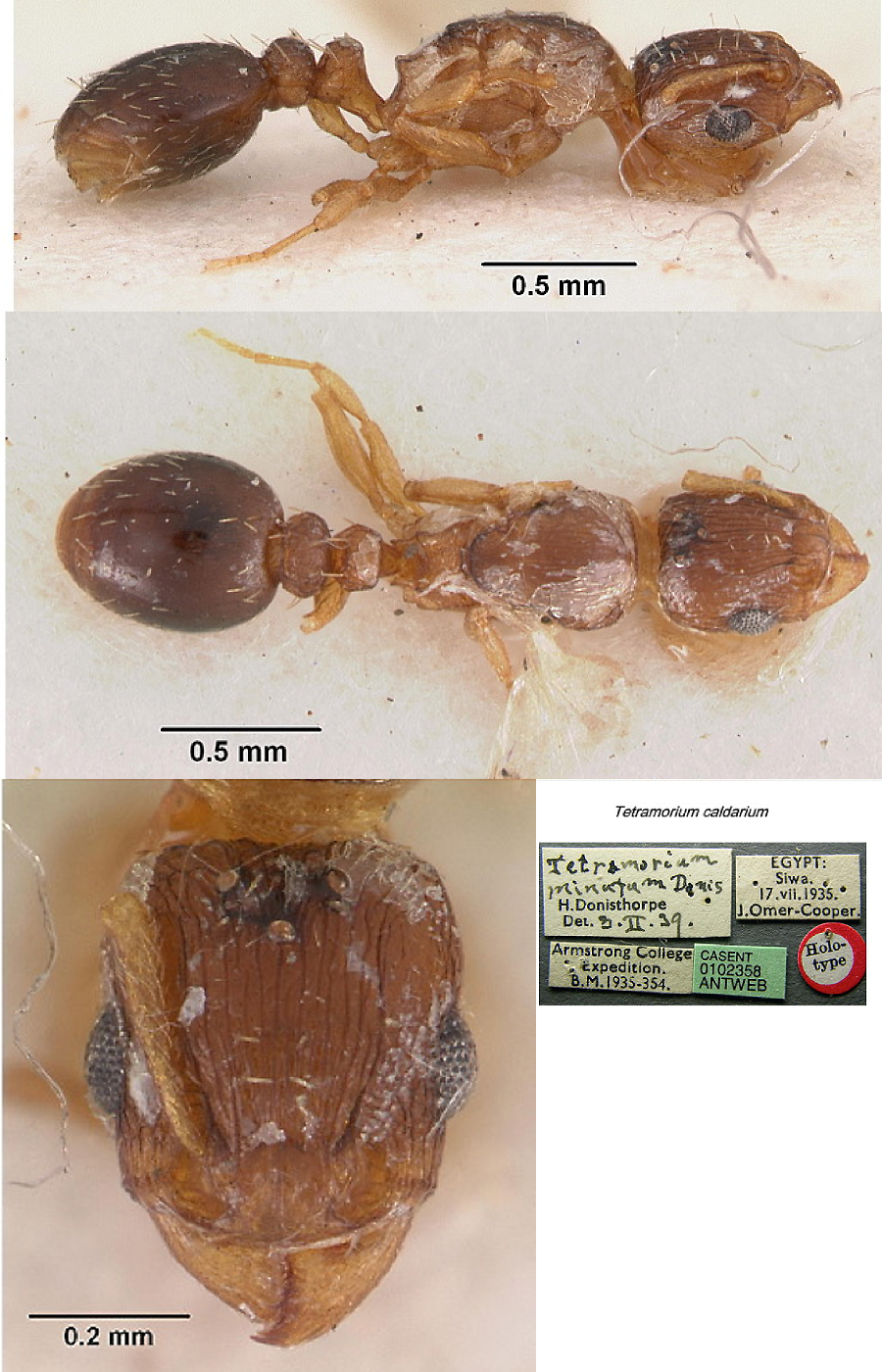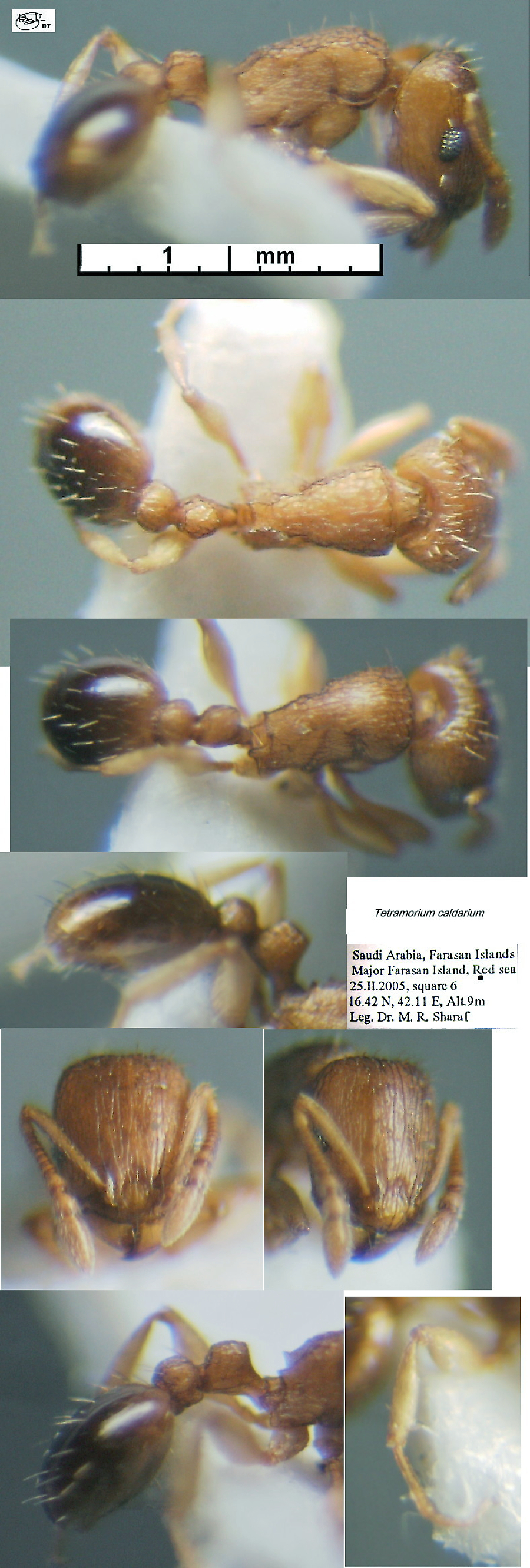Tetramorium caldarium (Roger)
 Type location Germany (Tetrogmus
caldarius n. sp., Roger, 1857: 12, worker; Meinert, 1861: 331,
male) from a hothouse at Rauden, near Dresden - see https://www.antweb.org/specimenImages.do?code=casent0102333 Type location Germany (Tetrogmus
caldarius n. sp., Roger, 1857: 12, worker; Meinert, 1861: 331,
male) from a hothouse at Rauden, near Dresden - see https://www.antweb.org/specimenImages.do?code=casent0102333
junior synonyms
hemisi (as variety of pusillum,
Wheeler, 1922: 193, worker) from Zaïre, Niangara by H.O. Lang,
in the stomach of a frog - see http://www.antweb.org/specimenImages.do?code=casent0003150
minutum (Tetramorium
minutum sp. n., Donisthorpe, 1942a: 30, queen) from Egypt,
Siwa - see below
transformans (Tetramorium
pauper stirps transformans nov., Santschi, 1914b: 104,
worker) from Kenya, Shimoni, xi.1911, Alluaud & Jeannel -
no images on Antweb (April 2015)
(see Bolton, 1995)  . .
|
Roger's (1857) description is at  and and  . Santschi's (1914b) description of transformans
is at . Santschi's (1914b) description of transformans
is at  . Donisthorpe's (1942a)
description of minutum is at . Donisthorpe's (1942a)
description of minutum is at  . .
|
 Bolton's
modern descriptions are at - (1979, based primarily on New
World specimens) Bolton's
modern descriptions are at - (1979, based primarily on New
World specimens)  and (1980) and (1980)  . .
WORKER - TL 2.1-2.4 mm; with weak frontal carinae and
little trace of antennal scrobes. Short, stout blunt hairs on all
dorsal surfaces of the body. Colour yellow or light yellowish brown
(Bolton, 1980, not illustrated).
A panglobal tramp species, which Bolton (1980) thought
to be of African origin. The sole West African records which he listed
were from Nigeria, at the savannah location of Mokwa (B.
Lasebikan); and Ivory Coast, at ORSTOM (W.L. Brown).
|
 In his blanket description, Bolton (1980) wrote of his
suspicion that there are two closely similar species, differing
particularly in the width between the frontal carinae at the level of
the eyes. Specimens from East Africa and India had this separation as
< 0.50 X HW, whereas most Old World and all New World specimens had
HW > 0.50 HW. From the specimens shown below, it seems that another
consistent feature of the type form is a uniformly dark gaster. In the
East African & Saudi Arabia specimens the gaster has variably
lighter areas. In his blanket description, Bolton (1980) wrote of his
suspicion that there are two closely similar species, differing
particularly in the width between the frontal carinae at the level of
the eyes. Specimens from East Africa and India had this separation as
< 0.50 X HW, whereas most Old World and all New World specimens had
HW > 0.50 HW. From the specimens shown below, it seems that another
consistent feature of the type form is a uniformly dark gaster. In the
East African & Saudi Arabia specimens the gaster has variably
lighter areas.
For more on the confused mess of susbspecies and
synonyms see http://antsofafrica.org/ant_species_2012/tetramorium/tetramorium_simillimum/tetramorium_simillimum_variability.htm
|
Oxford University Museum
specimens
Tetramorium caldarium
B Taylor det. |
Egypt
Mostafa Sharaf
|
17.viii.2007
Marsa Matrouh
31°21' N
27°14' E
|
Kaseh Tourist Village
|
1
|
 |
Tetramorium caldarium
B Taylor det. |
Saudi Arabia
Mostafa Sharaf
|
25.ii.2005
Farasan Islands
16°42' N
42°11' E
|
Major Farasan I.,
Red Sea
|
1
|
 |
|
 Egypt
records - in HNS as Tetramorium
minutum Donisthorpe (1942a) single queen from Siwa Oasis,
collected by J Omer-Cooper, 17.vii.1935. Photomontage collated from http://www.antweb.org/specimen.do?name=casent0102358 Egypt
records - in HNS as Tetramorium
minutum Donisthorpe (1942a) single queen from Siwa Oasis,
collected by J Omer-Cooper, 17.vii.1935. Photomontage collated from http://www.antweb.org/specimen.do?name=casent0102358
|
 The
photomontage is of a worker from Egypt, Kaseh; collector
Mostafa Sharaf The
photomontage is of a worker from Egypt, Kaseh; collector
Mostafa Sharaf
|
 The
photomontage is of a specimen from Saudi Arabia, Farasan
Islands, Major Farasan I., Red Sea, 25.ii.2005; 16°42' N, 42°11' E,
collector Mostafa Sharaf. The
photomontage is of a specimen from Saudi Arabia, Farasan
Islands, Major Farasan I., Red Sea, 25.ii.2005; 16°42' N, 42°11' E,
collector Mostafa Sharaf.
|
|